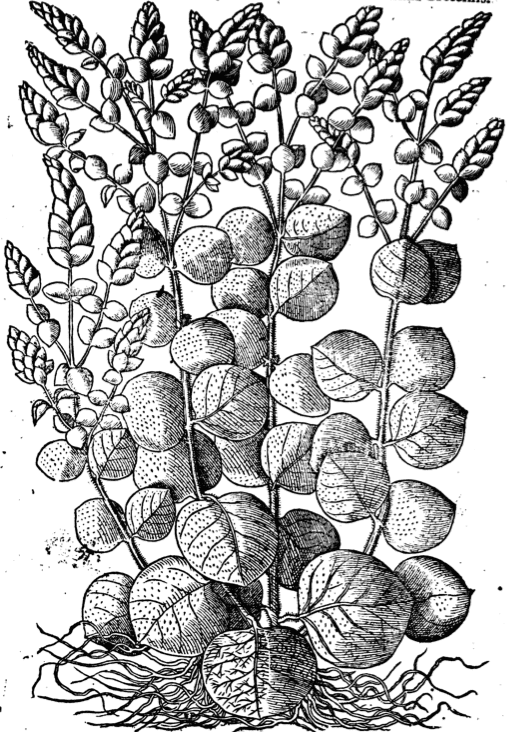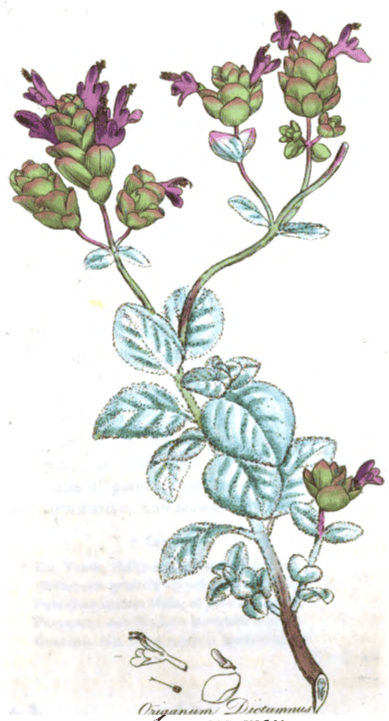Origanum dictamnus, Dittany of CreteBastard Dittany, Dictamnus of Candia |

|

|

|
|
New Kreuterbuch, Matthiolus, 1563 |
Medical Botany, Woodville, 1810 |
Botanical name:
Origanum dictamnus (syn. Dictamnus creticus)
Parts used:
Herb
Temperature & Taste:
Warm, dry. Pungent, Bitter
Uses:
1. Moves Blood, Promotes Menstruation:
-Promotes Urine, expels a Dead Fetus (Galen)
-Amenorrhea, Dysmenorrhea
-Uterine diseases associated with Blood stasis
-promotes Birth, clears Dead Child and Afterbirth
–Hippocrates regarded it as the primary medicine to cleanse the Afterbirth
2. Moves the Blood, Clears Stasis:
-Wounds, Trauma, Bruising
3. Moves Qi, Opens Obstructions:
-abdominal pain and distention, colic
-nausea
-promotes Urine (Galen)
4. Clears Wind-Cold:
-Headache, Dizziness
-Cough, Wheezing
5. Resists Poison:
-poisoned Wounds, poison Sores
-draws out Thorns, Splinters and things from the flesh
Dose:
Herb in Powder: 1–3 grams (½–1 dram);
Decoction in Water or Wine: 3–6 grams (1–2 drams); these doses were prescribed to promote delivery and expel a dead fetus.
Substitute:
1. Salmon said “It has the virtues of the former [White Dittany] (but not altogether so powerful) and is especially dedicated to the Womb’.
2. Pliny said “pseudodictamon” Ballota pseudodictamnus was used in its place.
3. Theophrastus said it was similar in smell and virtue to Pennyroyal.
4. Marjoram
Main Combinations:
1. To promote Menstruation:
i. Dittany of Crete with Mugwort, Pennyroyal, Calamint, Balm
ii. Dittany of Crete with Pennyroyal, Celery root, Calamus, Bay Berry, Zedoary
ii. To strongly promote Menstruation, Dittany of Crete with Myrrh and Savin
2. To promote Labor and cleanse the Afterbirth:
i. Dittany of Crete with Savin and Cinnamon
ii. Dittany of Crete with Savin, Myrrh, Galbanum, Gum Ammoniac made into pills with Syrup of Mugwort (Fuller)
3. Trauma, Bruising:
i. Dittany of Crete with St. Johns wort, Rhubarb, Madder, Sanicle
ii. Dittany of Crete with Burdock root, Madder, Rhubarb, St. Johns wort, Sanicle, Bugle (Fuller)
4. Epilepsy: Mistletoe, Dittany of Crete (20 each), prepared Black Hellebore root, Valerian (10 each), Nerium oleander (15), with Honey (50), form an electuary; Dose: quarter teaspoon, twice daily. (Landerer)
5. Hectic Fever, Consumption: Dittany of Crete, with Tormentil, Bistort, Swallow-wort, Scorzonera, Viper
Major Formulas:
Syrup of Mugwort (Augustana)
Electuary of Scordium
Triphera Minor (Triphera Phoenonis, Triphera Minus) (Mesue)
Cautions:
Not used during Pregnancy
Main Preparations used:
Tincture, Distilled Water, Saline Tincture
-
Extra Info
-
History
|
‘It is the hind, too, that, as already stated, first made us acquainted with dictamnon, or dittany; for when wounded, it eats some of this plant, and the weapon immediately falls from the body. This plant grows nowhere but in Crete. The branches of it are remarkably thin; it resembles pennyroyal in appearance, and is hot and acrid to the taste. The leaves are the only part employed, it being destitute of blossom, seed, and stem: the root is thin, and never used. In Crete even, it is found growing only in a very limited locality, and is sought by goats with singular avidity. ‘In place of it, the pseudodictamnum is employed, a plant that is found growing in many countries. In leaf it is similar to the other, but the branches are more diminutive: by some persons it is known as “chondris.” Its properties not being so strongly developed, the difference is immediately recognized: for an infusion of the very smallest piece of the real dittany, is sufficient to burn the mouth. The persons who gather it are in the habit of enclosing it in a stem of fennel-giant or in a reed, which they close at the ends that the virtues of it may not escape. Some persons say, that both plants grow indiscriminately in numerous localities, the inferior sort being the produce of rich soils, and the genuine dittany being found nowhere but in rugged, uncultivated spots. |
‘There is, again, a third plant called ” dictamnum,” which, however, has neither the appearance nor the properties of the other plant so called; the leaves of it are like those of sisymbrium, but the branches are larger. ‘There has long been this impression with reference to Crete, that whatever plant grows there is infinitely superior in its properties to a similar plant the produce of any other country; the second rank being given to the produce of Mount Parnassus. In addition to this, it is generally asserted that simples of excellent quality are found upon Mount Pelion in Thessaly, Mount Teleuthrius in Euboea, and throughout the whole of Arcadiaand Laconia. Indeed, the Arcadians, they say, are in the habit of using, not the simples themselves, but milk, in the spring season more particularly; a period at which the field plants are swollen with juice, and the milk is medicated by their agency. It is cows milk in especial that they use for this purpose, those animals being in the habit of feeding upon nearly every kind of plant. The potent properties of plants are manifested by their action upon four-footed animals in two very remarkable instances: in the vicinity of Abdera and the tract known as the Boundary of Diomedes, the horses, after pasturing, become inflamed with frantic fury; the same is the case, too, with the male asses, in the neighbourhood of Potniae. (The Natural History of Pliny, trans. by Bostock and Riley, Vol. 5, 1856) |
